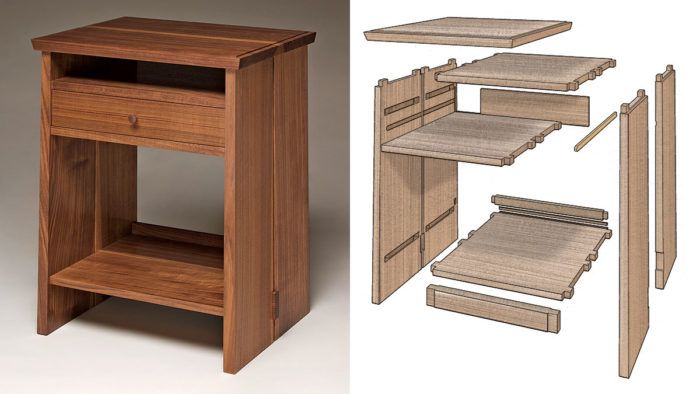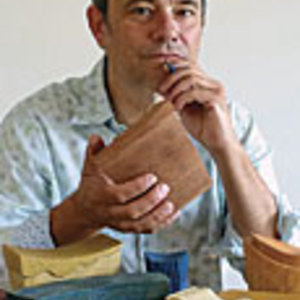How to Build a Nightstand
Housed tenons deliver strength, and tapers create a refined appearance
Synopsis: With its convenient shelf, drawer, and lower storage space, this nightstand is perfect for those who like to keep a lot of reading material next to the bed. The design features housed mortise-and-tenon joints, and the sides of the case are tapered both in thickness and in width. A beveled, stepped detail adds interest around the top, and a stretcher beneath the lower shelf has exposed tenons. The backbone of the project is the housed mortise-and-tenon joint, which has a stub tenon, or haunch, between full tenons. This gives the joint maximum strength, ensures a tight joint line, and prevents any warping.
I designed this piece for a retired librarian who wanted a nightstand that would double as a bookcase. Of course it needed a drawer, which I sized to accommodate pencils and paper or an iPad, along with other items. Since so many essential things compete for space on the top of a nightstand—lamp, water glass, books and periodicals, alarm clock, eyeglasses—I decided to drop the drawer a few inches below the top, creating an easily reached space for the night’s reading matter. Below the drawer I left ample room to store a collection of favorite books and magazines.

Even while juggling these functional considerations, I was sharply focused on the nightstand’s form. The design is essentially rectilinear, but I didn’t want it to read as blocky and plain.
Aiming to add visual interest and give the piece a subtly elegant presence, I made each side from a pair of boards with a narrow gap between them. I also tapered the sides slightly both in thickness and in width. I added a beveled, stepped detail around the top, and a stretcher beneath the lower shelf with tenons that protrude through the case sides.
The nightstand’s primary joinery is a favorite of mine for solid-wood casework: the housed mortise-and-tenon. Between its full tenons the joint has stub tenons, or haunches, that tuck into a mating dado, or housing. This arrangement gives the joint maximum shear strength; keeps the tenoned member from warping; hides any small openings that develop over time; and, because it has relatively small shoulders, makes it easier to ensure a tight joint line. I learned the housed tenon from my mentor, David Powell, at the school he ran in Massachusetts, Leeds Design Workshops. I’ve relied on this joint heavily over the years, and I think it’s unparalleled in soundness and strength.
Photo: Don Russel
For the full article, download the PDF below:
Fine Woodworking Recommended Products

Jorgensen 6 inch Bar Clamp Set, 4 Pack

Bessey EKH Trigger Clamps

Starrett 12-in. combination square

Get the Plan
Buy the extended Digital Plan























Comments
really attractive piece. what marking gauge is he using on page 54? it looks like it holds pencil lead??
Are plans available for this?
To: user-6808639, yes they are. See: https://www.tauntonstore.com/walnut-nightstand.html
How is the drawer built no info ?????
The drawer is detailed in the plans: https://www.tauntonstore.com/walnut-nightstand-digital-plan-065188.html
I purchased the detailed plans and have a question about the top. It appears that the indent on the top around the edge is a different width. One end is shown as 9/16 the other end is shown as 1/2. Is this a design thingy or a mistake in the drawing?
The drawing is correct. The rabbet along the front edge of the top is 9/16 in. wide while the rabbets on the other three sides are 1/2 in. wide. As far as I can see, you could modify the plan if you wish and make the front rabbet the same width as the others. It won't affect anything else.
Log in or create an account to post a comment.
Sign up Log in